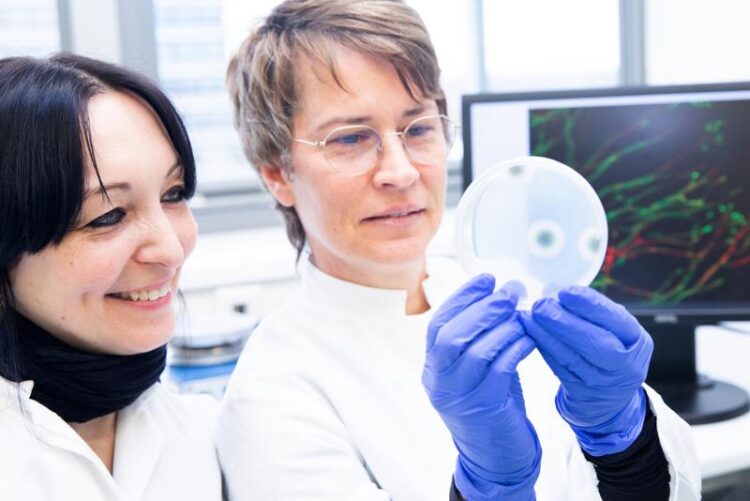Drug from cancer chemotherapy helps fight deadly fungal infections

Keeping an eye on the Aspergillus biofilm: Professor Dr. Françoise Routier (right) and her research assistant Patricia Zarnovican.
Copyright: Karin Kaiser / MHH
Infections with the fungus Aspergillus fumigatus are difficult to fight – especially because the fungus forms a biofilm and can thus protect itself from antifungal drugs and the immune defence system. The cancer drug Imatinib prevents the compartmentalisation.
There are up to 10,000 fungal spores in every cubic metre of air that can enter our bodies when we breathe them in. Some of these belong to the species Aspergillus fumigatus, a widespread fungus found everywhere in the environment. In immunocompromised people – for example, after transplantation or severe respiratory illnesses such as influenza or COVID-19 – the fungus can enter the lungs and cause aspergillosis.
The infection is particularly difficult to treat – especially because the fungus surrounds itself with a biofilm. This acts like a kind of glue and enables Aspergillus to take hold in the tissue. In addition, the fungus seals itself off in this way and protects itself against attacks by the immune system and especially against antimycotics, i.e. anti-fungal drugs.
A research team led by Professor Dr. Françoise Routier from the Institute of Clinical Biochemistry at the Hannover Medical School (MHH) has found a way to prevent the formation of such an Aspergillus biofilm with the help of a drug from cancer chemotherapy. The study was carried out with support from the RESIST Cluster of Excellence and has been published in the International Journal of Molecular Sciences.
Sugar molecule is important for biofilm formation
Aspergillus fumigatus is a so-called opportunistic fungus that takes advantage of a weakened immune system and can cause diseases of varying severity, from allergies to fatal mycoses. The infection starts in the lungs but can spread through the bloodstream to the brain, heart, liver and kidneys, affecting more than 300,000 people each year. In the respiratory tract, Aspergillus is embedded in a biofilm that forms a barrier against immune system defence cells and antimicrobials. “One of the main components of this biofilm is a sugar molecule that the fungus produces itself and then transports outside into its immediate environment,” explains Professor Routier. There, the sugar molecule is chemically modified by an enzyme called deacetylase Agd3. This step is essential for the fungus to stick to the body tissue. The researchers were able to prove this: Biotechnologically modified fungi that lacked the enzyme Agd3 could no longer produce a biofilm.
The biochemist’s idea was now to look for a substance that inhibits the enzyme Agd3 and thus prevents the formation of the biofilm. To do this, she used computers to search so-called drug libraries for active substances that are already approved and inhibit precisely this Agd3 activity. In-silico screening is the name of the method in the language of science – and it led to the trace of a drug called imatinib, which is used in chemotherapy. In cell culture, imatimib was able to significantly reduce the Aspergillus biofilm. Studies on larvae of the butterfly Galleria mellonella also confirmed the effect. The caterpillars of the “great wax moth” serve as a model organism for research into biofilms caused by microorganisms such as fungi or even bacteria. “We infected the larvae with Aspergillus and saw that fewer caterpillars died when treated with the chemotherapeutic agent,” says Professor Routier.
Imatinib must lose its effect as a cytotoxin
Before imatinib can be used against biofilms in humans, however, the drug still needs to be chemically modified. “The drug destroys the protective layer of the fungal colony, but as a chemotherapeutic agent it also acts as a cytotoxin, which is undesirable for this application,” the biochemist explains. If the cytotoxic effect can be removed without losing the Agd3 inhibitory effect, the biofilm destroyer could at least mitigate the problem of increasing resistance to the antimycotics used. “This gives us great hope for the development of new combination therapies against the fungus,” says Professor Routier.
SERVICE:
The original paper “Identification of Compounds Preventing A. fumigatus Biofilm Formation by Inhibition of the Galactosaminogalactan Deacetylase Agd3” can be found here: https://www.mdpi.com/1422-0067/24/3/1851/html
For further information, please contact Professor Dr. Françoise Routier, routier.francoise@mh-hannover.de, phone (0511) 532-9807.
Media Contact
All latest news from the category: Health and Medicine
This subject area encompasses research and studies in the field of human medicine.
Among the wide-ranging list of topics covered here are anesthesiology, anatomy, surgery, human genetics, hygiene and environmental medicine, internal medicine, neurology, pharmacology, physiology, urology and dental medicine.
Newest articles

A universal framework for spatial biology
SpatialData is a freely accessible tool to unify and integrate data from different omics technologies accounting for spatial information, which can provide holistic insights into health and disease. Biological processes…

How complex biological processes arise
A $20 million grant from the U.S. National Science Foundation (NSF) will support the establishment and operation of the National Synthesis Center for Emergence in the Molecular and Cellular Sciences (NCEMS) at…

Airborne single-photon lidar system achieves high-resolution 3D imaging
Compact, low-power system opens doors for photon-efficient drone and satellite-based environmental monitoring and mapping. Researchers have developed a compact and lightweight single-photon airborne lidar system that can acquire high-resolution 3D…





















